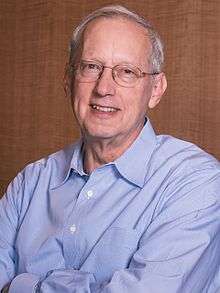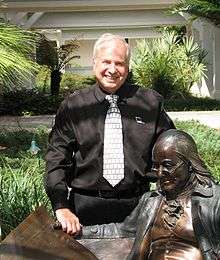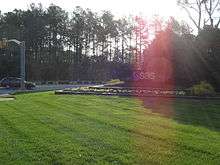SAS Institute
 | |
| Private Company | |
| Industry | Software |
| Founded | July 1, 1976 |
| Founder |
Anthony James Barr James Goodnight John Sall Jane Helwig |
| Headquarters | Cary, North Carolina, U.S. |
Key people |
James Goodnight, CEO and Co-founder John Sall, Co-founder and Executive Vice President |
| Revenue |
|
Number of employees | 14,158 (2016)[1] |
| Website | www.sas.com |
Coordinates: 35°49′37″N 78°45′44″W / 35.82694°N 78.76222°W
SAS Institute (or SAS, pronounced "sass") is an American multinational developer of analytics software based in Cary, North Carolina. SAS develops and markets a suite of analytics software (also called SAS), which helps access, manage, analyze and report on data to aid in decision-making. The company is the world's largest privately held software business[2] and its software is used by most of the Fortune 500.[3]
SAS has developed a model workplace environment and benefits program designed to retain employees, allow them to focus on their work, and reduce operating costs. It provides on-site, subsidized or free healthcare, gyms, daycare and life counseling services.
SAS Institute started as a project at North Carolina State University to create a statistical analysis system (hence the proper name, Statistical Analysis System) that was originally used primarily by agricultural departments at universities in the late 1960s. It became an independent, private business led by current CEO James Goodnight and three other project leaders from the university in 1976. SAS grew from $10 million in revenues in 1980 to $1.1 billion by 2000. A larger proportion of these revenues are spent on research and development than at most other software companies,[4] at one point more than double the industry average.[5]
History



The Statistical Analysis System (SAS) began as a project at North Carolina State University's agricultural department. It was originally led by Anthony James Barr in 1966, then joined by NCSU graduate student James Goodnight in 1967[6] and John Sall in 1973.[7] In the early 1970s, the software was primarily leased to other agricultural departments[8] in order to analyze the effect soil, weather and seed varieties had on crop yields.[2] The project was funded by the National Institutes of Health and later by a coalition of university statistics programs called the University Statisticians of the Southern Experiment Stations.[7]
By 1976 the software had 100 customers[9][10] and 300 people attended the first SAS user conference in Kissimmee, Florida that year.[11] Goodnight, Barr, Sall and another early participant, Jane Helwig, founded SAS Institute Inc. as a private company on July 1, 1976, in offices across the street from the university.[7][12] Barr and Helwig later sold their interest in the company.[6]
SAS' tradition of polling users for suggestions to improve the software through the SASWare Ballot was adopted during its first year of operation.[13][14] Many of the company's employee perks, such as fresh fruit, reasonable work hours[3] and free M&M's every Wednesday became part of the company's practices that first year.[15][16][17] In the late 1970s, the company established its first marketing department.[18]
SAS started building its current headquarters in a forested area of Cary, North Carolina in 1980.[19][20] Later that year it started providing on-site daycare in order to keep an employee that was planning on being a stay-at-home mom.[3] By 1984, SAS had begun building a fitness center, medical center, on-site cafe and other facilities.[3] It had also developed some of its other benefits programs.[21][22] SAS became known as a good place to work[22] and was frequently recognized by national magazines like BusinessWeek, Working Mother and Fortune for its work environment.[17][23]
During the 1980s, SAS was one of Inc. Magazine's fastest growing companies in America from 1979 and 1985.[18][23] It grew more than ten percent per year from $10 million in revenues in 1980[6] to $1.1 billion by 2000.[23] In 2007, SAS revenue was $2.15 billion, and in 2013 its revenue was $3.02 billion. By the late 1990s, SAS was the largest privately held software company.[21] The Associated Press reported that analysts attributed the growth to aggressive R&D spending.[24] It had the highest ratio of its revenues spent on R&D in the industry for eight years, setting a record of 34 percent of its revenues in 1993, as it was working on a new menu-based interface.[14] The company began its relationship with Microsoft and development for Windows operating systems in 1989. Shortly afterwards it established partnerships with database companies like Oracle, Sybase and Informix.[14]
An education division was created in 1997 to create software for schools, including the newly formed Cary Academy. In 2003 the Bank of America Foundation purchased and donated licenses for the software to 400 schools in North Carolina.[25] SAS funded its first advertising program in 2000 with a $30 million television and radio campaign.[23]
The company considered making 25 percent of the company available on the stock market and providing employees with stock-options during the dot-com bubble before the following downturn, but ultimately chose not to.[26] SAS was one of the few technology companies that did well during the downturn and hired aggressively to take advantage of available staff.[21]
In 2009, SAS filed a lawsuit against World Programming Ltd., alleging World Programming System—a software product designed to use the features of the SAS language—violated their copyright as it was reverse engineered from the functionality of SAS Learning Edition.[27] The European Court of Justice ruled that functionality and language elements[28] were not protected and the case was discussed in Oracle v. Google[29]
SAS introduced its first reseller program intended to grow sales with small to medium-sized businesses in 2006.[30][31] Leading up to 2007, SAS provided funding and curriculum assistance to help start the Master of Science in Analytics program at nearby North Carolina State University.[32] The company's cloud-based products grew in revenues by 35 percent in 2014[33] and the construction of Building Q was completed late that year to house its corresponding operations.[34]
In March 2014, SAS launched its SAS Analytics U[35] initiative to provide free foundational technologies and support to teachers and students.
Operations
SAS Institute has grown in revenue each year since it was incorporated in 1976.[3][36][37] About 20-30% of the company's revenues are spent on research and development, which is the highest ratio among software companies of its size.[3][4] In 1994, Computerworld found that out of the world's 50 largest software companies, SAS spent 2.5 times the industry average on R&D.[5] As of 2010 revenues come relatively evenly from Europe, Africa, the Middle East and the Americas.[3] According to the company's 2014 financial reporting, its revenues are currently 46.7 percent from the Americas, 41.4 from Europe, Middle East and Africa, and 11.9 percent from Asia-Pacific.[38] SAS has about 5,200 employees at its headquarters in Cary, North Carolina, 1,600 employees elsewhere in the US and 6,900 in Europe, Asia, Canada or Latin America.[39] CEO James Goodnight owns about two-thirds of the company and co-founder John Sall owns the other one-third.[9][40]
Workplace
SAS is well known for its workplace culture.[36][41] The company was used as a model for workplace perks at Google[3] and is taught as a case study in management seminars at Stanford.[15] SAS has been identified as a "Best Company to Work For" in Fortune's annual rankings each year since the list's inception in 1997.[21][42] In 2014, SAS ranked No. 2 on the elite Top 25 World's Best Multinational Workplaces list from Great Place to Work as well as No. 2 among Fortune’s 2014 Best Companies to Work For in the US. SAS was No. 1 on the US list in 2010 and 2011. On March 5, 2015, Fortune ranked SAS No. 4 on its annual list of best companies to work for in the US. On March 5, 2016, Fortune ranked SAS No. 8, down from number 4 in 2015 on its annual list of best companies to work for in the US. It is also regularly in Working Mother Magazine's "100 Best Companies for Working Mothers" list.[14]
Benefits

SAS offers on-site day care services to its employees for 850 children for about a third of the normal cost. Medical services are provided to employees and their families for free and 80% of the cost is covered for specialists.[15] Employees are encouraged to work 35-hour weeks[15] and have free access to a recreation and fitness center[4] as well as life counseling services.[15] It also hosts a summer camp for children[3] and operates on-site cafeterias and cafes.[3] 22.5 tons of M&Ms are provided each year, in jars that are re-filled every Wednesday.[4] Similar amenities are provided at its other offices besides its headquarters.[43][44]
95 percent of a company’s assets drive out the front gate every night, the CEO must see to it that they return the following day.— James Goodnight, quoted in Management: Inventing and Delivering Its Future[45]
SAS spokespeople say its employee benefits are provided for business, not altruistic, reasons.[4][15] The company evaluates new benefits using three criteria: whether it would benefit the company culture, whether it would serve a significant number of employees and whether it would save more money than is spent on it.[4] According to academics, the company's practices improve the loyalty, focus and creativity of its staff.[3] Professor Jeffrey Pfeffer from the Stanford Graduate School of Business estimated that the company saves $60–$80 million annually in expenses related to employee turnover.[46] SAS has an annual employee turnover of three[15] to five[4] percent, while the software industry's average is 20[15] to 25 percent.[21] According to USA Today, the workplace culture has created "intensely loyal" staff who care about the company's well-being.[21] Even though there are unlimited sick days, the average employee takes only two. The 40,000 free medical visits provided to employees annually are estimated to cost the company $4.5 million USD, but save it $5 million USD due to the employee productivity lost when staff spend their work-hours in waiting rooms at other hospitals.[3]
Structure and culture
SAS has a limited corporate hierarchy[36] and an egalitarian culture. As the company grew it created new divisions, instead of layers of management, creating a flat, simple organizational structure.[4][44] According to professor Jeffrey Pfeffer from Stanford, there are only three levels in the organization and CEO Jim Goodnight has 27 people who directly report to him. The organizational structure is fluid and employees can change roles rapidly.[47]
Managers are involved in the day-to-day work with their employees.[4] Employees are given a large extent of autonomy[4] and developers are encouraged to pursue experimental product ideas. Input from customers guides the company's marketing and software development.[14] According to SAS, 80 percent of suggestions for product improvements are incorporated into the software.[4] The dress code is informal.[4] According to Fast Company, employees describe the environment as "relaxed."[4]
Employees are encouraged to do volunteer work and the company makes donation to non-profits where employees are involved.[48] The company primarily focuses its philanthropic efforts on improving education. It funds pilot programs for new education models, donates laptops and provides free online software for classrooms called Curriculum Pathways.[40]
Acquisitions
| Year | Company | Business | Country | References |
|---|---|---|---|---|
| 2012 | rPath, Inc. | Software appliance | |
[49] |
| 2012 | aiMatch, Inc. | Digital ad serving technology | |
[50] |
| 2011 | AssetLink | Integrated Marketing Management | |
[51] |
| 2010 | Vision Systems and Technology (VSTI) | Advanced Analytics Professional Services | |
[52] |
| 2010 | Memex | Intelligence Management Software | |
[53] |
| 2008 | Teragram | Natural Language Processing | |
[54] |
| 2008 | IDeaS | Revenue Management Software for the hospitality industry. | |
[55] |
| 2006 | Veridiem | Customer Intelligence | |
[56] |
| 2003 | Marketmax | Merchandise Planning and Analytics Software | |
[57] |
| 2003 | Risk Advisory | Risk Management | |
[13] |
| 2003 | OpRisk Analytics LLC | Management Consulting Services | |
[58] |
| 2002 | Verbind Software | Behavioral Tracking and Event-Triggering Software | |
[59] |
| 2002 | ABC Technologies Inc. | Software Developer and Wholesaler | |
[60] |
| 2001 | Intrinsic Ltd | Campaign Management Software | |
[61] |
| 2000 | DataFlux | Data Quality, Data Integration and Master Data Management | |
[62] |
| 1997 | Statview Life Sciences software from Abacus Concepts | Business Analytics | |
[63] |
| 1993 | GESCAN International, Inc. | Document and Workflow Management Systems | |
[64] |
| 1988 | NeoVisuals Inc. | 3D Computer Graphics and Animation Software | |
[65] |
| 1986 | The Lattice C compiler, often considered the first C programming language on the IBM PC | C Compiler | |
[65] |
| 1984 | The System 2000 Database Management System from Intel Corporation | Database Management | |
[65] |
Software
As of 2012, SAS is the largest privately owned software company in the world.[66] It develops, supports and markets a suite of analytics software also called SAS (statistical analysis system), which captures, stores, modifies, analyzes and presents data.[5] The SAS system and SAS programming language are used by most of the Fortune 500.[3] The SAS software includes a Base SAS component that performs analytical functions and more than 200 other modules that add graphics, spreadsheets or other features.[14][67] SAS Institute also sells the JMP suite of statistical analysis software, which consists of JMP, JMP Pro, JMP Clinical and JMP Genomics.[68]
Some of the uses for SAS' software include analyzing financial transactions for indications of fraud, optimizing prices for retailers, or evaluating the results of clinical trials.[3][66] As of 2012, SAS is the largest market-share holder in the advanced analytics segment with a 36.2 percent share and the fifth largest for business intelligence software with a 6.9 percent share.[69] SAS typically sells its software with an emphasis on subscription models that include support and updates, as opposed to software licenses.[44]
User community
The SAS certification program was established in 1999.[70] and SAS Publishing was created in 2000 as a separate entity that works to increase the availability of SAS-related books.[71] SAS Publishing hosts an online bookstore, develops product documentation and publishes SAS-related books authored by users.[44][71][72] There are more than 200 SAS users groups devoted to a specialty, an individual client, or a geography. There are local, regional, national and international users groups[14][44]
See also
References
- ↑ Topic, Business (May 25, 2016). "About SAS". SAS. Retrieved August 23, 2016.
- 1 2 Lohr, Steve (November 21, 2009). "At a Software Powerhouse, the Good Life Is Under Siege". The New York Times. Retrieved September 27, 2011.
- 1 2 3 4 5 6 7 8 9 10 11 12 13 14 Kaplan, David (January 22, 2010). "SAS: A new no. 1 best employer". Fortune. Retrieved April 8, 2014.
- 1 2 3 4 5 6 7 8 9 10 11 12 13 Fishman, Charles (December 31, 1998). "Sanity Inc.". Fast Company.
- 1 2 3 Anthes, Gary (November 24, 1997). "Pillar of the community". Computerworld. p. 91.
- 1 2 3 Eisenstadt, Steven (July 21, 1996). "SAS: A hard-to-define product but simple success". News & Observer. Retrieved May 19, 2014.
- 1 2 3 Alan Agresti; Xiao-Li Meng (November 2, 2012). Strength in Numbers: The Rising of Academic Statistics Departments in the U. S.: The Rising of Academic Statistics Departments in the U.S. Springer. p. 177. ISBN 978-1-4614-3649-2.
- ↑ Charles A. O'Reilly; Jeffrey Pfeffer (2000). Hidden Value: How Great Companies Achieve Extraordinary Results with Ordinary People. Harvard Business Press. p. 101. ISBN 978-0-87584-898-3.
- 1 2 Lane, Randall (November 8, 2007). "Pampering the customers, pampering the employees". Forbes. Retrieved April 10, 2014.
- ↑ Wayne Cascio (August 2011). Responsible Restructuring: Creative and Profitable Alternatives to Layoffs. ReadHowYouWant.com. p. 120. ISBN 978-1-4596-2635-5.
- ↑ Oral History Interview with Jim Goodnight, Oral Histories of the American South, July 22, 1999, retrieved April 8, 2014
- ↑ Nourse, E. Shepley; Greenberg, Bernard G.; Cox, Gertrude M.; Mason, David D.; Grizzle, James E.; Johnson, Norman L.; Jones, Lyle V.; Monroe, John; Simons, Gordon D. (1978). "Statistical Training and Research: The University of North Carolina System". International Statistical Review / Revue Internationale de Statistique. 46 (2): 171. doi:10.2307/1402812. ISSN 0306-7734. JSTOR 1402812.
- 1 2 Company History, SAS, retrieved April 9, 2014
- 1 2 3 4 5 6 7 Romani, Jane (December 1993). "SAS Institute: 21st Century Technology ... Today". Business Leader.
- 1 2 3 4 5 6 7 8 Leung, Rebecca (February 11, 2009). "Working the Good Life". CBS News. Retrieved October 17, 2011.
- ↑ Marron, Kevin (October 14, 1999). "Firms use perks to relieve HR stress Massages, health clubs and M&Ms among extras that keep staff happy and productive". The Globe and Mail. pp. T4.
- 1 2 Darrow, Barbara (December 12, 2005). "James Goodnight, Founder and CEO, SAS Institute". Computer Reseller News. p. 23.
- 1 2 Buchanan, Leigh (September 2011). "How SAS Continues to Grow". Inc. Magazine. Retrieved September 28, 2011.
- ↑ "SAS corporate timeline". WRAL. March 3, 2011. Retrieved October 17, 2011.
- ↑ Nowell, Paul (June 28, 1992). "Cary software firm handles growth without losing human touch". Associated Press. Retrieved April 8, 2014.
- 1 2 3 4 5 6 Maney, Kevin (April 21, 2004). "SAS Workers Won When Greed Lost". USA Today. Retrieved October 17, 2011.
- 1 2 Nowell, Paul (June 15, 1997). "Software company SAS Institute evolving along with its customers". Associated Press. Retrieved April 8, 2014.
- 1 2 3 4 Dalesio, Emery (May 5, 2001). "Little-known software giant to raise its profile". Associated Press. Retrieved April 8, 2014.
- ↑ "SAS Institute continues rapid growth". Associated Press. July 13, 1992.
- ↑ Dalesio, Emery (August 18, 2003). "SAS to offer free software to schools". Associated Press. Retrieved April 8, 2014.
- ↑ Harvey, Fiona (July 6, 2001). "SAS Institute delays plans for partial flotation". Financial Times. p. 24.
- ↑ Aoife White (2012-05-02). "Copyright Can't Block Software Reverse Engineering: Court". Bloomberg. Retrieved 2014-09-23.
- ↑ Vezzoso, Simonetta (2012). "Copyright, Interfaces, and a Possible Atlantic Divide" (PDF). Journal of Intellectual Property, Information Technology and E-Commerce Law. 3 (2): 153–161.
- ↑ Garling, Caleb (2012-05-07). "In Oracle v. Google, Judge Holds Fate of Java APIs". Wired.com. Retrieved 2014-09-23.
- ↑ Dalesio, Emery (August 28, 2006). "SAS Institute targets smaller businesses". The Associated Press. Retrieved April 8, 2014.
- ↑ Cowley, Stacy (August 28, 2006). "SAS Institute Shakes up BI Space with Reseller Effort; Company changes course after years of selling products direct". Computer Reseller News.
- ↑ Glazer, Emily (October 24, 2011). "Problems-and Solutions". The Wall Street Journal. Retrieved April 9, 2014.
- ↑ Rani, David (October 22, 2014). "SAS foresees adding 600 workers in Cary over next 3 years". The Cary News. Retrieved November 13, 2014.
- ↑ Arellano, Nestor (October 22, 2014). "SAS expands cloud analytics business". IT World Canada. Retrieved November 13, 2014.
- ↑ Meyer, Leila (March 24, 2014). "SAS Launches SAS Analytics U". Campus Technology. Retrieved August 11, 2015.
- 1 2 3 Shivapriya, N (September 25, 2008). "SAS Steams Along as Unlisted Firms Amid US Financial Chaos". The Economic Times. Retrieved October 17, 2011.
- ↑ Buchanan, Leigh (September 2011). "How SAS Continues to Grow". Inc. Magazine. Retrieved May 9, 2014.
- ↑ "SAS surpasses $3 billion in 2013 revenue, growing 5.2% over 2012 results" (Press release). SAS Institute. January 23, 2014. Retrieved September 22, 2014.
- ↑ Company facts and financials, SAS Institute, retrieved May 9, 2014,
2013 R&D investment: 25% of revenue
- 1 2 Bankhert, Ellen; Lee, Mary; Lange, Candice, SAS Institute: A case (with teaching note) on the role of senior business leaders in driving work/life cultural change (PDF), University of Pennsylvania, retrieved April 9, 2014
- ↑ Hardy, Quentin (June 9, 2011). "SAS-We Spurned IBM, Now to Win". Forbes. Retrieved October 17, 2011.
- ↑ Wiscombe, Janet (October 8, 2010). "SAS Optimas Award Winner for General Excellence, 2000". Workforce.com. Retrieved October 18, 2011.
- ↑ Creating cultures that lead to success: Lincoln Electric, Southwest Airlines, and SAS Institute, 41 (1), Organizational Dynamics, January–March 2012, pp. 32–43
- 1 2 3 4 5 Pfeffer, Jeffrey (January 1998), SAS Institute: A Different Approach to Incentives and People Management Practices in the Software Industry, Graduate School of Business, Stanford University, retrieved September 22, 2014
- ↑ Thomas A. Kochan; Richard Schmalensee (2003). Management: Inventing and Delivering Its Future. MIT Press. p. 117. ISBN 978-0-262-11282-6.
- ↑ Cathleen Benko; Anne Weisberg (December 30, 2013). Mass Career Customization: Aligning the Workplace With Today's Nontraditional Workforce. Harvard Business Press. p. 111. ISBN 978-1-4221-3868-7.
- ↑ Joel, Kurtzman (July 1, 1998). "An Interview with Jeffrey Pfeffer". Strategy+Business. Retrieved April 10, 2014.
- ↑ Shields, Anthony (February 16, 2013). "Good Business: 10 Companies With Ethical Corporate Policies". Minyanville. Retrieved May 16, 2014.
- ↑ Malik, Om (November 28, 2012). "Cloud app services company rPath acquired by SAS". GigaOm. Retrieved April 10, 2014.
- ↑ Exchanger, Ad (February 21, 2012). "SAS Acquires aiMatch". AdExchanger. Retrieved February 21, 2014.
- ↑ Collins, Kimberly (February 23, 2011), Assetlink Buy Moves SAS Into Software as a Service and Mainstream MRM, Gartner, retrieved November 20, 2011
- ↑ "Cary's SAS buys VSTI". News Observer. July 17, 2010. Retrieved November 20, 2011.
- ↑ Hubler, David (June 23, 2010). "Acquisition boosts SAS' goal of security market leadership". Washington Technology. Retrieved April 10, 2014.
- ↑ Kanaracus, Chris (March 17, 2008). "SAS buys natural language processing vendor Teragram". IDG. Retrieved November 20, 2011.
- ↑ Lager, Marshall (August 7, 2008). "SAS Institute Gets Some Bright Ideas". Retrieved April 10, 2014.
- ↑ By Hannah Smalltree, Tech Target. SAS snaps up Veridiem for MRM. March 16, 2006. Retrieved November 20, 2011.
- ↑ Callaghan, Dennis (August 2003). "SAS Buys Marketmax". eWeek. Retrieved November 20, 2011.
- ↑ Callaghan, Dennis (October 25, 2004). "SAS Takes on Sarb-Ox Compliance". eWeek. Retrieved April 10, 2014.
- ↑ Campanelli, Melissa (November 19, 2002). "SAS Buys Verbind Tech Assets". Direct Marketing News. Retrieved November 20, 2011.
- ↑ Earnshaw, Aliza (March 10, 2002). "ABC Technologies agrees to acquisition by SAS". Portland Business Journal. Retrieved November 20, 2011.
- ↑ Callaghan, Dennis (February 4, 2001). "SAS Moves to Strengthen CRM Suite". eWeek. Retrieved November 20, 2011.
- ↑ Henschen, Doug (February 23, 2010). "SAS's DataFlux Intros Management Platform". TechWeb. Retrieved December 14, 2011.
- ↑ "SAS acquires StatView". R&D Magazine. 39 (12). November 1997. p. 61.
- ↑ "Gescan International Finds More Platforms". Computer Business Review. May 6, 1993.
- 1 2 3 SAS Institute to Step Up Investment and Acquisition Efforts, February 8, 2000, retrieved November 20, 2011
- 1 2 Lohr, Steve (March 26, 2012). "BITS; Seeking an Edge in Data Analysis". The New York Times. Retrieved April 17, 2014.
- ↑ John R. Schermerhorn (October 11, 2011). Exploring Management. John Wiley & Sons. p. 3. ISBN 978-0-470-87821-7.
- ↑ Taylor, James (August 10, 2011). "First Look – JMP Pro". JTonEDM. Retrieved May 31, 2012.
- ↑ Vesset, Dan; David Schubmehl; Brian McDonough; Mary Wardley (June 2013). "Worldwide Business Analytics Software 2013–2017 Forecast and 2012 Vendor Shares". IDC. Retrieved October 2, 2013.
- ↑ Balfour, Gail (May 6, 1999). "Certification program validates SAS users". Computerworld Canada. Retrieved September 22, 2014.
- 1 2 "SAS Institute to create publishing arm". The Dispatch. July 1, 2000. Retrieved April 8, 2014.
- ↑ Publish with SAS, SAS Institute, retrieved April 9, 2014
External links
| Wikimedia Commons has media related to SAS Institute. |